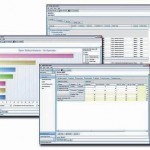Up to this point, the PCB assembly industry has lacked a common language regarding the nature of traceability. Practical Components and Aegis Software partnered to overcome this lack.
All manufacturers who aspire to achieve or to maintain a world class status must deliver some degree of traceability. Up to this point, the PCB assembly industry has lacked a common language regarding the nature of traceability. Nor has there been a means to benchmark such capability or to communicate its nature to customers or regulatory agencies in a common manner.
Practical Components, the leading supplier of dummy components and process testing kits, and Aegis Software, a leader in manufacturing information management systems, partnered to design an innovative kit to validate and benchmark the entire manufacturing process and provide the potential for rich product and process traceability detail. This new ‘Traceability and Control Validation Kit’ provides the physical materials and the procedural guide to determine a factory’s traceability and control capability, and then rate the results in a formalized matrix. These ratings can be used to demonstrate capabilities, communicate to customers or auditors, or to provide a start point for manufacturers to improve their capabilities and track progress along the way.
Traceability is one of the most common terms used in manufacturing but it lacks a common definition across any discrete manufacturing industry. According to ISO 8402, traceability is ‘the ability to trace the history, application or location of an entity by means of recorded identifications. Tracing is the capability to identify the origin of a particular unit located within the supply chain by reference to records held upstream in the supply chain. Units are traced for purposes such as recall and complaints.’ Even this definition, however, permits a broad interpretation by the reader.
Defining the Total Equation of Traceability
The very term ‘traceability’ actually only describes the end but does not describe the means. To audit and rate traceability in a manner that could grant a manufacturer a high traceability metric when all they have is a method of reporting how poorly they build product is not productive. They must have both the means to ensure a controlled process and to prove they have such a process through data fulfilment. The complete equation of traceability can be summed in this technical belief: Traceability is the natural byproduct of a properly controlled and monitored factory operation, not the goal in itself.
How traceability is addressed within an organization ranges from ‘basic’ to ‘true’ traceability solutions. Basic solutions resolve immediate needs and are typically point solutions. True traceability solutions consider both the immediate and long terms needs and broadly cover manufacturing operations. These solutions can be viewed at hierarchical levels:
- 1. Solutions to obtain material content information from a physical location or data source;
- 2. Solutions to process variables from a physical location or data source;
- 3. Process-wide architecture to obtain material and process variable information from every step in the manufacturing flow;
- 4. Process-wide architecture that achieves the former level, but also implements physical electronic control to assure the process being traced is correct.
Rating Traceability: How the Metric is Obtained
The Traceability Ratings Guide is contained within a Microsoft Excel workbook and considers use of basic to true traceability systems with a means for scoring a given manufacturer’s capabilities. It may be used for all discrete manufacturing processes where material is installed into a product. It generically covers both electronic and mechanical assembly processes, thereby offering a means to reflect a traceability score across an entire factory.
The guide’s Summary page includes an array of scores based on how the manufacturer completed the workbook. The cell rows cover the different manufacturing areas that contribute to overall traceability. The cell columns identify the various aspects as to how traceability is measured. This page also serves as a dynamic table of contents, where clicking on the area entries or scores navigates the user to the desired section of the workbook.
The ratings guide does not provide a single final score, as weighing criteria for each area against themselves is extremely arbitrary. Instead, the guide returns scores in report card form for the following areas:
- General Tracking Methods – how traceability is performed within the manufacturing operations;
- Revisions and Change Notices – how assembly revisions are managed and approved for use for the manufacturing operations;
- Product WIP – product-travel related areas;
- Material Content – material related areas and how material associated to a given product is verified during the manufacturing process;
- Inspection and Test – inspection and test actions performed for a given product;
- Ratings Guide Worksheet Layout Explained
- The criteria in each worksheet are presented in questionnaire form and are organized by the following categories:
- Manufacturing Practices Performed Within The Factory – actions and steps taken by the manufacturer;
- Controls Ensuring Manufacturing Practices – how manufacturing practices are controlled,
- Reporting and Evidence of Above Actions – actual traceability capabilities.
Under each category, criteria are grouped by functions performed by the manufacturer. The manufacturer supplies a percentage value for each entry within a grouping to determine how often it is performed in their operations. The supplied percentage is multiplied by the entry’s maximum value and contributes to the group’s overall score. Each group is weighted and contributes to the category’s overall score.
Uses of a Common Ratings System
While the spirit of traceability provides tangible proof against a manufactured product, evidence of a given manufacturer’s traceability potential is not easy. With a scoring system, the ratings guide can also support a means to measure the following:
- Rate factories across an enterprise – A corporation can rank the capabilities found at each plant and identify the locations in the best position to support traceability-sensitive manufacturing.
- Rate lines within a factory – A contract manufacturer can promote advanced capabilities to potential customers for lines dedicated to traceability-sensitive manufacturing.
- Program management – Program managers can make intelligent decisions to where products are most effectively run.
- Sales executives – Sales team can communicate traceability capabilities accurately and intelligently.
- Quantify improvement –The guide reveals areas that require addressing, and in a manner that allows the manufacturer to consider all traceability aspects and forge a traceability roadmap.
- Costing – Scores can correlate to a cost of assets and systems necessary to support a current and future state.
Improving traceability capabilities is an important driver for most manufacturers today. Until now it has been impossible to quantify traceability across manufacturing locations and industries. A common ratings guide, independent of the manufacturer, provides a normalized gauge, and therefore a common language, as to how traceability is communicated. It is not intended to create a comparison of one manufacturer vs. another, but instead to establish a way to factor traceability with equally weighted criteria.
EPPE431
About Aegis
Aegis Software Corporation is a leading global developer of innovative software solutions for manufacturing information environments. The company’s Manufacturing Operations System (MOS) software offers high-reliability manufacturers the tools needed to fully optimize their manufacturing processes, providing a critical complement to enterprise-level ERP and PLM capabilities.
Aegis’ products fully manage the manufacturing information environment, from process planning and launch, through manufacturing execution and shop floor materials control, to operations analytics and real-time dashboard systems. This holistic solution yields unprecedented product, process, and materials traceability, as well as the data fulfillment and visibility manufacturers need for competitive improvement. With a customer base of more than 1,000 corporations across the electronics assembly, medical equipment/device, automotive, and military/aerospace markets, 28 manufacturing equipment supplier partnerships, and eight consecutive years of independent customer satisfaction awards, Aegis delivers a unique level of capability, value, and time-to-value for its manufacturing customers.
Zusammenfassung
Lückenlose Nachverfolgbarkeit über alle Produktionsvorgänge hinweg ist für die Elektronikfertigung eine wichtige Voraussetzung. Doch fehlen hier Standards und Normen. Für die Unternehmen Practical Components und Aegis Software war das ein Grund, sich gemeinsam des Themas anzunehmen.
La traçabilité sans faille à travers toutes les opérations de production est une condition préliminaire importante à la fabrication des composants électroniques. Malheureusement, ce domaine est dépourvu de standards et de normes. C’est pourquoi les sociétés Practical Components et Aegis Software se sont emparées du sujet pour présenter une solution commune.
Share:











